The Museum of UnCut Funk salutes John E. DeCoste aka Terry Carter. Terry was born in Brooklyn, New York on December 16, 1928, the only child of William and Mercedes DeCoste. Terry’s mother was a native of the Dominican Republic. His father was American born, of Argentine and African-American descent.
 Terry’s parents taught him Spanish as well as English as a child. Growing up in a bilingual, bicultural household, in a predominantly Italian, Williamsburg neighborhood, next door to a Jewish synagogue, was an early influence in developing Terry’s appreciation for cultural diversity.
Terry’s parents taught him Spanish as well as English as a child. Growing up in a bilingual, bicultural household, in a predominantly Italian, Williamsburg neighborhood, next door to a Jewish synagogue, was an early influence in developing Terry’s appreciation for cultural diversity.
Terry remembers walking his first picket line at age 8, at his father’s side, in a demonstration to support demands for better conditions for recipients of “home relief”, as the welfare program of the day was called. 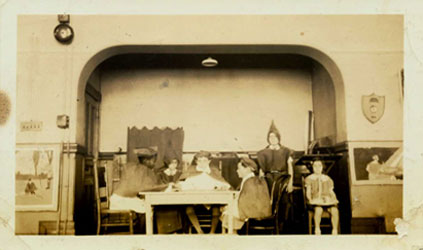 At the age of 9, Terry acted for the very first time: in the role of the 15th century Portuguese explorer “Vasco da Gama” in a historical play about the discovery of America, in auditorium of his elementary school, P.S. 88 in Brooklyn.
At the age of 9, Terry acted for the very first time: in the role of the 15th century Portuguese explorer “Vasco da Gama” in a historical play about the discovery of America, in auditorium of his elementary school, P.S. 88 in Brooklyn.

When Terry graduated Stuyvesant High School in New York City in 1946, he enlisted in the merchant marine to see the world. As a crew member on the SS Marine Marlin, he sailed to Germany and walked among the utter devastation that was once the proud port of Bremerhaven. The merchant ship took on as passengers displaced persons, and former prisoners of war and concentration camp survivors and transported them from Germany and other European ports to Venezuela, Argentina and Brazil. After six months as a seaman, Terry took a job as a mail clerk at New York’s Museum of Modern Art.
 As part of the museum’s program, the museum film department exhibited a seemingly endless film festival of avant-garde independent and foreign films. Terry tried to see every one of them. The year that he spent at the museum altered his life course: he became an ardent devotee of the arts and an avid film buff. He made acquaintances with many young painters and writers, some of whom later became famous.
As part of the museum’s program, the museum film department exhibited a seemingly endless film festival of avant-garde independent and foreign films. Terry tried to see every one of them. The year that he spent at the museum altered his life course: he became an ardent devotee of the arts and an avid film buff. He made acquaintances with many young painters and writers, some of whom later became famous.
After that year, Terry went off to Northeastern University in Boston to study pre-law. While there, he worked weekends as a “piano player” with a jazz combo, drawing on his experience of classical piano study from age 8 through 15. They played at night clubs, and for weddings and bar mitzvahs. In the 1950s, while studying law at St. John’s University Law School in New York, he met the well-known theatre actors Howard Da Silva and Morris Carnovsky. They convinced him to consider the pursuit of a career as an actor.
 Realizing that drama training would help him in the courtroom, he studied law by day and acting by night. His first drama teacher was Howard Da Silva, who offered him a scholarship at Actors Mobile Theatre, Da Silva’s acting school. Terry took classes in Method Acting. It wasn’t long before he lost interest in the prospects of a law career: After his second year at law school, he dropped out and began to study acting full-time. As a young teenager, Terry had already taken on the nickname “Terry”, after the adventurous young hero of the popular newspaper cartoon Terry & the Pirates by Milton Caniff. Terry kept on using the name through high school. When he got into show business, he got tired of the white people asking him how come he had a foreign-sounding last name, since most African Americans they knew had Anglo-Saxon surnames such as Wilson, Jones or Jackson. So, Terry switched from “DeCoste” to the more English-sounding “Carter” for his professional name, as did many actors of that era who had foreign-sounding names (e.g. Kirk Douglas, John Garfield and Jack Benny), and has used it ever since. 
Realizing that drama training would help him in the courtroom, he studied law by day and acting by night. His first drama teacher was Howard Da Silva, who offered him a scholarship at Actors Mobile Theatre, Da Silva’s acting school. Terry took classes in Method Acting. It wasn’t long before he lost interest in the prospects of a law career: After his second year at law school, he dropped out and began to study acting full-time. As a young teenager, Terry had already taken on the nickname “Terry”, after the adventurous young hero of the popular newspaper cartoon Terry & the Pirates by Milton Caniff. Terry kept on using the name through high school. When he got into show business, he got tired of the white people asking him how come he had a foreign-sounding last name, since most African Americans they knew had Anglo-Saxon surnames such as Wilson, Jones or Jackson. So, Terry switched from “DeCoste” to the more English-sounding “Carter” for his professional name, as did many actors of that era who had foreign-sounding names (e.g. Kirk Douglas, John Garfield and Jack Benny), and has used it ever since. 
Terry’s acting career started in 1952 with a leading role in Edward Chodorov’s Decision, at the Greenwich Mews Theatre in Greenwich Village. He became a member of the theatre group and the following year, in Les Pine’s play, Monday’s Heroes, he played the part of a teenager in a Jewish family, with no special makeup. It was an early experiment in non-traditional casting. Terry studied with Herbert Berghof, Uta Hagen and Stella Adler in those years. Terry landed his first Broadway role in 1954, as the male lead opposite Eartha Kitt, in the play Mrs. Patterson. The company toured major cities before opening on Broadway at the National Theater, for a run of several months. Later, he played the part of “Howard” in the revival of E.Y. Harburg’s Finian’s Rainbow (1955) at the City Center Theater.
In 1956, Terry was one of the first black actors on equal-footing as a regular on a TV sitcom series, portraying “Private Sugarman” on Phil Silvers’ Sgt. Bilko (aka You’ll Never get Rich aka The Phil Silvers Show). The series lasted four years, and was the model for subsequent comedy series about the military, such as Hogan’s Heroes and McHale’s Navy. In 1957, Terry played the title role in “Bob Thomas of the Philadelphia Inquirer”, part of The Big Story series which focused on the outstanding achievements of journalists. A non-smoker, Terry had to learn to smoke in order to play key scenes in the teleplay.
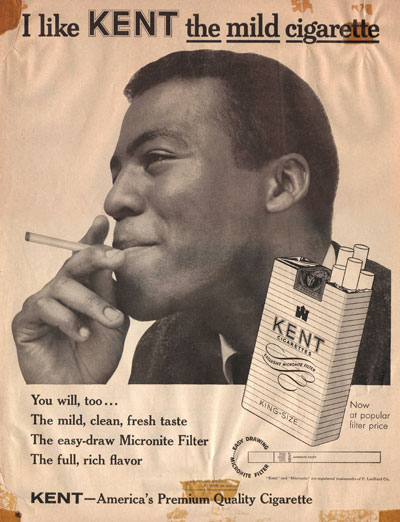 The series sponsor was Pall Mall cigarettes, and the show was broadcast live, so it was crucial that Terry smoke convincingly. He carried it off, but he has never smoked another cigarette since.
The series sponsor was Pall Mall cigarettes, and the show was broadcast live, so it was crucial that Terry smoke convincingly. He carried it off, but he has never smoked another cigarette since.
In 1962, Terry returned to Europe for an extended stay. He lived some months in Paris and then spent a year in Denmark before moving onto Rome. In Rome, he learned to speak fluent Italian. Terry fell in love with his language tutor, the Italo-Yugoslavian Anna Scratuglia. In the fall of 1963, Terry returned to the United States. In 1964, he asked Anna to join him in New York. They married and later had two children: a son, Miguel, and a daughter, Melinda, both of whom were raised speaking Italian as well as English.
In 1965, walking up Broadway one day, Terry ran into a producer friend who suggested that he do a screen test for the position of TV newscaster. Although he had no journalistic background, he drew upon his 13 years of experience as an actor and landed the job: Terry Carter became world’s first black TV anchor newscaster, for WBZ-TV Eyewitness News in Boston, the Westinghouse flagship station, for the next 3 years. 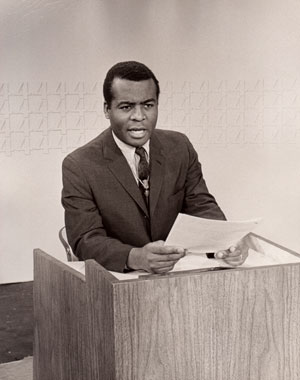 In addition to covering crime stories and “hard” news, Terry became Boston TV’s first opening night drama and movie critic. Even though Terry was now a TV newscaster, he still maintained his relationship with the William Morris Agency.
In addition to covering crime stories and “hard” news, Terry became Boston TV’s first opening night drama and movie critic. Even though Terry was now a TV newscaster, he still maintained his relationship with the William Morris Agency.
While summering in Rome in 1967, Terry was sent by the Morris Agency to meet Italian producer Dino deLaurentiis and avant-garde art film director Tinto Brass, who asked him to star in his movie, Nerosubianco (aka Black on White or Attraction), set in London. Since he was still a TV newscaster, Terry had to request a 13-week leave of absence from his news anchor job, in order to work in the film. Although it was an unprecedented request for Westinghouse, he got it. Before long, he realized that his first love was acting. Once his three-year newsroom contract was up, he packed his bags and he and his wife moved to Hollywood, in search of greener pastures.
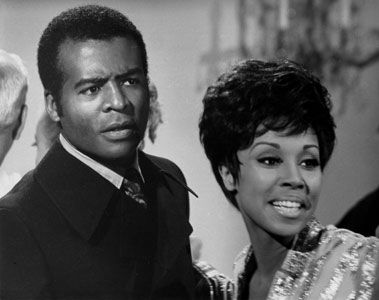 His first important role on arriving in Hollywood in 1968 was as a detective named “Jaffie”, in the made-for-TV movie Company of Killers, in which he worked alongside Van Johnson and Ray Milland. From 1968-71, singer Diahann Carroll became the first Black female to star in her own TV sitcom series, Julia. Terry had a recurring role as Julia’s boyfriend “Bert”.
His first important role on arriving in Hollywood in 1968 was as a detective named “Jaffie”, in the made-for-TV movie Company of Killers, in which he worked alongside Van Johnson and Ray Milland. From 1968-71, singer Diahann Carroll became the first Black female to star in her own TV sitcom series, Julia. Terry had a recurring role as Julia’s boyfriend “Bert”.
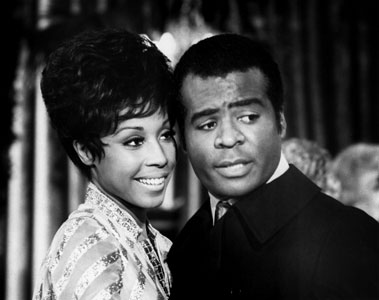
In December 1969, only 5 months after Neil Armstrong takes his first step onto the Moon, Terry played the role of “Mike Carter”, the first Black astronaut to the Moon, in The Bold Ones: The New Doctors. Many of the scenes were filmed in the actual Apollo Spacecraft.

During the 1970’s Terry starred in several Blaxploitation films, including the 1974 film Foxy Brown with Pam Grier. He also starred in Abby 1974, and Brother on the run 1973. In 1975, Terry founded Meta-4 Productions, Inc., a small Los Angeles production company, through which he produced and directed more than one hundred industrial and educational films and videos for public broadcasting and for virtually every agency of the federal government. Terry also formed the Council for Positive Images, Inc., (CPI) a non-profit organization of which he is still president, in 1979, dedicated to enhancing intercultural and interethnic understanding through audiovisual communication. Under the Council’s auspices, he has produced and directed award-winning dramatic and documentary programs for PBS, focusing on cultural and historical topics.
In 1978, McCloud’s creator Glen Larson and producer Leslie Stevens were asked to make a major film for television in response to the success of the Star Wars trilogy of George Lucas.  Star Wars special effects specialist John Dykstra and his team were brought in to start on the models for what would become the most expensive film ever made for television: Battlestar Galactica: Saga of a Star World. The cast was a mix of young, still relatively unknown actors like Richard Hatch and Dirk Benedict, combined with legends as Bonanza’s Lorne Greene, Ray Milland, Lew Ayres and Alfred Hyde-White.
Star Wars special effects specialist John Dykstra and his team were brought in to start on the models for what would become the most expensive film ever made for television: Battlestar Galactica: Saga of a Star World. The cast was a mix of young, still relatively unknown actors like Richard Hatch and Dirk Benedict, combined with legends as Bonanza’s Lorne Greene, Ray Milland, Lew Ayres and Alfred Hyde-White.
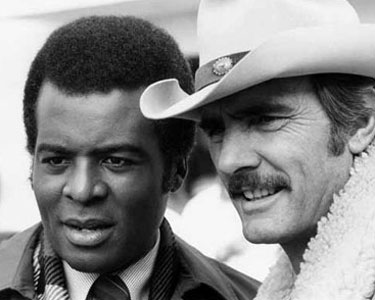 Terry, who’d just worked with creator Glen Larson and producer Leslie Steven on McCloud for 7 years, was selected for the part of “Lt. Boomer”. As chance would have it, Terry broke his ankle roller skating with his daughter a shortly before Galactica started filming. The part of “Lt. Boomer” was then re-cast and given to young actor Herb Jefferson, Jr. But the 7 years on McCloud must have made an impression on its producers, because Terry was later offered another part in the series: that of “Colonel Tigh”, the right hand of “Commander Adama”. Still a warrior rather then a diplomat, “Tigh” was often at odds with “Adama” on his decisions. It was a part Terry found even more challenging and satisfying to play Since Battlestar Galactica: Saga of a Star World cost an enormous amount of money to make it was quickly decided to turn it into a TV series. A combination of multiple last-minute script revisions, the costs of $1 million per episode and a bad TV time slot made the network decide to cancel the show after just one season.
Terry, who’d just worked with creator Glen Larson and producer Leslie Steven on McCloud for 7 years, was selected for the part of “Lt. Boomer”. As chance would have it, Terry broke his ankle roller skating with his daughter a shortly before Galactica started filming. The part of “Lt. Boomer” was then re-cast and given to young actor Herb Jefferson, Jr. But the 7 years on McCloud must have made an impression on its producers, because Terry was later offered another part in the series: that of “Colonel Tigh”, the right hand of “Commander Adama”. Still a warrior rather then a diplomat, “Tigh” was often at odds with “Adama” on his decisions. It was a part Terry found even more challenging and satisfying to play Since Battlestar Galactica: Saga of a Star World cost an enormous amount of money to make it was quickly decided to turn it into a TV series. A combination of multiple last-minute script revisions, the costs of $1 million per episode and a bad TV time slot made the network decide to cancel the show after just one season.
 Terry made a reprise in 1999 and played the part of now “President Tigh” in Richard Hatch’ trailer Battlestar Galactica: The Second Coming, an attempt to revive the original series. In 1980, Terry was elected to the Board of Governors of the Academy of Television Arts & Sciences, where he served two terms. In 1983, Terry was inducted into the Academy of Motion Picture Arts and Sciences. He served on the Documentary Committee and the Foreign Films Committee for the Oscars. That same year, Northeastern University awarded him a Bachelor of Science degree in Communications. In 1985, Terry received a Los Angeles Emmy Award for K*I*D*S, a TV miniseries he created, produced and directed. K*I*D*S was the story of a multi-racial group of teenagers struggling to cope with some of the adult-sized conflicts confronting youth in America today. In 1987-88, Terry produced and directed JazzMasters, a series of video portraits of twelve great jazz artists for TV2 Denmark. The series featured interviews and performances of Chet Baker, Kenny Drew, Dexter Gordon, Johnny Griffin, Herbie Hancock, Bobby Hutcherson, Carmen McRae, James Moody, Niels-Henning, Wayne Shorter, Clark Terry, and Randy Weston. In 1988, Terry produced and directed the award-winning, Emmy-nominated TV musical documentary A Duke Named Ellington about the life and work of pianist, composer, bandleader and jazz legend Duke Ellington. Making this documentary required Terry to spend a lot of time in Copenhagen, Denmark, where Duke’s son Mercer lived.
Terry made a reprise in 1999 and played the part of now “President Tigh” in Richard Hatch’ trailer Battlestar Galactica: The Second Coming, an attempt to revive the original series. In 1980, Terry was elected to the Board of Governors of the Academy of Television Arts & Sciences, where he served two terms. In 1983, Terry was inducted into the Academy of Motion Picture Arts and Sciences. He served on the Documentary Committee and the Foreign Films Committee for the Oscars. That same year, Northeastern University awarded him a Bachelor of Science degree in Communications. In 1985, Terry received a Los Angeles Emmy Award for K*I*D*S, a TV miniseries he created, produced and directed. K*I*D*S was the story of a multi-racial group of teenagers struggling to cope with some of the adult-sized conflicts confronting youth in America today. In 1987-88, Terry produced and directed JazzMasters, a series of video portraits of twelve great jazz artists for TV2 Denmark. The series featured interviews and performances of Chet Baker, Kenny Drew, Dexter Gordon, Johnny Griffin, Herbie Hancock, Bobby Hutcherson, Carmen McRae, James Moody, Niels-Henning, Wayne Shorter, Clark Terry, and Randy Weston. In 1988, Terry produced and directed the award-winning, Emmy-nominated TV musical documentary A Duke Named Ellington about the life and work of pianist, composer, bandleader and jazz legend Duke Ellington. Making this documentary required Terry to spend a lot of time in Copenhagen, Denmark, where Duke’s son Mercer lived.
 In 1991, Terry was sent to China by the USIA (United States Information Agency), on a cultural lecture tour. He visited then-British Hong Kong, and Beijing, Chengdu, Chong Ching, Guang Zhou and Shen Yang, meeting Chinese filmmakers and students, and lecturing on his experience as a filmmaker in the U.S. In 1992, Terry started research and development on what is to become a 90-minute documentary for PBS about African-American anthropologist, dancer, and choreographer Katherine Dunham, whose show-stopping performances greatly influenced the evolution of American dance theatre. Terry’s biopic Katherine Dunham: Dancing with Life is about Ms. Dunham’s extraordinary life and work. In 1998, Terry appeared in the Swedish international thriller movie and TV miniseries Hamilton, in which he played “Texas Slim” head of the CIA.
In 1991, Terry was sent to China by the USIA (United States Information Agency), on a cultural lecture tour. He visited then-British Hong Kong, and Beijing, Chengdu, Chong Ching, Guang Zhou and Shen Yang, meeting Chinese filmmakers and students, and lecturing on his experience as a filmmaker in the U.S. In 1992, Terry started research and development on what is to become a 90-minute documentary for PBS about African-American anthropologist, dancer, and choreographer Katherine Dunham, whose show-stopping performances greatly influenced the evolution of American dance theatre. Terry’s biopic Katherine Dunham: Dancing with Life is about Ms. Dunham’s extraordinary life and work. In 1998, Terry appeared in the Swedish international thriller movie and TV miniseries Hamilton, in which he played “Texas Slim” head of the CIA.
Filmography:
- Battlestar Galactica: The Second Coming (1999)
- Trailer – Hamilton (1998)
- Battlestar Galactica: Saga of a World (1978)
- Abby (1974)
- Benji (1974)
- Foxy Brown (1974)
- Brother on the Run (1973)
- Nerosublanco (1969)
- Parrish (1961)
Source: Wikipedia, IMBD and Terry Carter.net


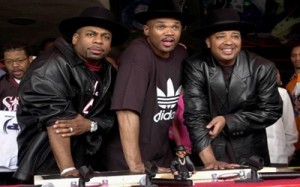
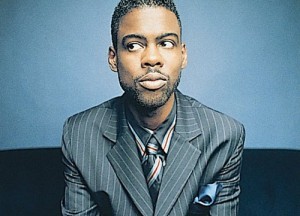


5 Comments
I’m not sure who put this together but it is very well written and informative (thank you for caring so much about my father!).Terry Carter is an amazing father, actor and producer and I am very proud of him. I love you, Pop!
A bit late, but having just read the obituary of Diahann Carroll I noticed a picture of your father. As a graduate student in Boston (several decades ago) I remember your dad as a newscaster and when I saw him in acting roles I remember wondering if it was the same Terry Carter from Boston news. Nice to know I’m not delusional! Delighted, also, that your name is Melinda which happens to be my middle name. Kindly let him know he’s remembered. I think I had a bit of a crush on him back in the 60’s!
I just saw this post! That is cool (about your name.) I’ll let him know. Thank you for your comment.
I was a boy of only seven years old at the time your father began his job as a weekend news anchor at WBZ-TV, Channel 4 in Boston. But I was also a pretty media savvy kid, so remember having sometimes watched your dad on “Eyewitness News.” It was also a pretty big deal when your dad was hired to work with Dennis Weaver in NBC’s “McCloud” series. And I even recall that fact being mentioned on a WBZ-TV newscast, perhaps even with an on-screen appearance by your dad at one time, when he returned for a visit to Boston.
You might also tell your dad, if he doesn’t already know, that the weekday evening news anchor at WBZ-TV when he worked there, Tom Ellis, just passed away in the last year. I am sure your dad knew Mr. Ellis fairly well. And Ellis’ voice had also often been compared to that of actor Robert Stack, whom Ellis even resembled a bit. Ellis would end up working at all three of Boston’s major TV stations–WBZ, WCVB (Channel 5) and WNEV (Channel 7, now the second Boston station with the call letters WHDH), with a stint at ABC in New York in-between his return to Boston and last position at New England Cable News before he retired.
But what I hadn’t known at the time your dad worked in Boston was he had alreday been an actor and appeared in Phil Silvers’ “Sergeant Bilko” series. That sitcom was, I think, created by Nat Hiken, the same person who created “Car 54 Where Are You?,” which featured its first and only regular black character, portrayed by the late great Nipsey Russell. That may seem like nothing today. but at the time it was a very big deal, because, with only three TV networks, millions of people watched those TV shows.
Hi! I just read your post; wow (you were seven years old.) Thank you for sharing, because I didn’t know any of that. It means a lot to me.